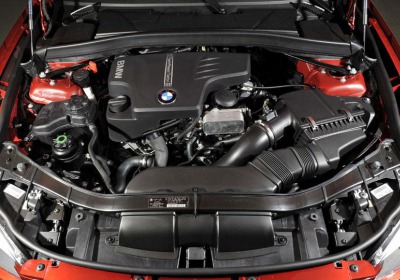BMW's N20 engine--four cylinders, more power
Fri, 18 Feb 2011
More power, greater torque, reduced fuel consumption, lower tailpipe emissions and less weight--but better? Before driving the BMW X1 xDrive28i, the first model to feature the German carmaker's new turbocharged 2.0-liter four-cylinder gasoline engine, we weren't so sure.
The new engine, known as the N20 and set to lead a return of four-cylinder BMW models to North America for the first time since 1998, has been conceived to (indirectly) replace the company's long-running naturally aspirated 3.0-liter inline six-cylinder. It's part of an ongoing downsizing program at the center of BMW's EfficientDynamics initiative.
The new four-cylinder follows the blueprint set by BMW's most recent turbocharged 3.0-liter inline six-cylinder, the N55. It boasts the same 3.5-inch bore center spacing and runs a twin-scroll turbocharger (albeit from Mitsubishi, not Borg Warner), Valvetronic variable valve timing, a Vanos camshaft control system and the latest high-pressure direct-injection system from Bosch. At 317.5 pounds, the engine weighs about 40 pounds less than the old naturally aspirated six-cylinder.
The BMW X1 crossover is the first vehicle to use the N20 turbocharged engine.
First impressions reveal the N20 to be up to the job. With peak power arriving 1,600 rpm earlier and peak torque arriving 1,350 rpm earlier than with the six-cylinder, the N20 doesn't have to be worked hard before delivering its best.
In everyday driving, the N20 is noticeably more responsive, although its sound is nowhere near as alluring as that of the engine it replaces. BMW says that will be fixed on certain models, including on an updated Z4 sDrive28i, with the addition of an electronic sound generator.
At 240 hp, the N20 develops 10 hp more than BMW's 3.0-liter inline-six in North America. It is terrifically refined and always feels urgent, with 260 lb-ft of torque on tap at 1,250 rpm. The power delivery is uncannily like that of a modern-day diesel, with particularly strong low-end attributes and impressive flexibility across a wide range of revs.
The six-speed manual version of the new X1 xDrive28i is claimed to reach 62 mph in 6.1 seconds, hit a top speed at 149 mph and boast a 50-mph-to-75-mph fourth-gear split at 6.0 seconds. By comparison, the current X1 xDrive28i sold in Europe, which uses a 258-hp version of BMW's 3.0-liter inline-six, posts figures of 6.8 seconds, 143 mph and 6.1 seconds, respectively.
Power builds in a smooth, free revving fashion without any hint of turbocharger lag. Work the N20 hard, and it revs happily to 7,000 rpm, although like most modern direct-injection units, there's a distinct lack of engine braking on a trailing throttle. The engine's powerful electronics package ensures maximum coasting potential is achieved by allowing the revs to fall away gradually.
Combining the N20 with BMW's familiar EfficientDynamics package-brake-energy regeneration, stop/start and an on-demand water pump--results in a 16 percent improvement over the inline-six in the combined European consumption cycle at 29.8 mpg (U.S.).
So the N20 is pleasing to drive and highly efficient. But, as it stands now, it's not as aurally entertaining nor as engaging as the six-cylinder it will eventually replace. Not yet, anyway. The potential is there, though.
By Greg Kable

